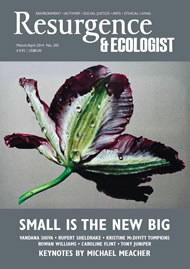The Book of Barely Imagined Beings by Caspar Henderson is the most beautiful publication I have read in many years. The amount of love and care that has been lavished on the design and illustration is matched only by the love and care that Caspar himself has poured into the text. Now out in paperback, it is much easier to carry; but I would recommend tracking down any remaining copies of the hardback to keep as presents for those you really love.
I have been a friend of Caspar’s for a long time. When we talked about progress on this book project – his modern-day bestiary – he smiled and nodded. But I just did not quite understand what was coming. I did not realise how much more than a listing of fantastical beings this would be. I should have known better, because Caspar is a writer of extreme charm, wit and intelligence.
Like many good writers from Oxford, Caspar was stimulated by a summer snooze. He had been reading Jorge Luis Borges’ The Book of Imaginary Beings – a bestiary of the wildest imaginings of the human mind. Sleep infused with creatures from Gilgamesh or Franz Kafka might not be the most restful, but it was certainly creative. “I woke with the thought that many real animals are stranger than imaginary ones, and it is our knowledge and understanding that are too cramped and too fragmentary to accommodate them: we have barely imagined them.”
The scale of Caspar’s ambition is as remarkable as the depth of his reading. I do not think I have ever come across a book that manages to slip in so many references to so many things I should have read.
In the space of a few paragraphs in his chapter on one of the strangest of creatures (the human), for example, Caspar references Nietzsche, the zoologist and artist Jonathan Kingdon and the comedian Billy Connolly. And this is a perfect mix of what he does. He takes deep philosophical ideas, leavens them with illustrations from the real world and then pays off with a joke.
Caspar suggests, channelling a little Nietzsche, that sanity “depends on steering a course between remembering too much and remembering too little”. Somehow he has woven this seamlessly into the chapter on Mystaceus, the jumping spider.
And while talking about flatworms, he takes a digression to the velvet worms and reveals that “their mating rituals – the male has a penis-like organ on his head, which he inserts into the female – and their virtuoso ability to squirt sticky slime in the face of enemies and prey have made them popular as pets”.
None of these tangents jar; Caspar has perfectly judged the digression coefficient to keep us on track, though we remain always interested in what sweet madness may be around the corner. His writing is funny and wise.
This book is a glorification of life on Earth – but the author does not stop at the wonder of it all. He uses each creature as a springboard into ideas as beautifully wild as the animals themselves. The Axolotl takes us off to wonder at fire, evolution and the potential for immortality. Barrel sponges lead to a discussion on symmetry, and the mantis shrimp to one on vision.
Caspar quotes Bertrand Russell: “The world is full of magical things patiently waiting for our wits to grow sharper.” The Book of Barely Imagined Beings is like a stone against which we can grind the blade of our wit – so that we are more able to tease out the wonders of the natural world from the avalanche of anthropocentric guff that threatens to overwhelm us all.
You are left in no doubt as to the wonder of life as you journey through this wonder-filled book. As Blake said, “he who kisses the joy as it flies lives in eternity’s sun rise”.







